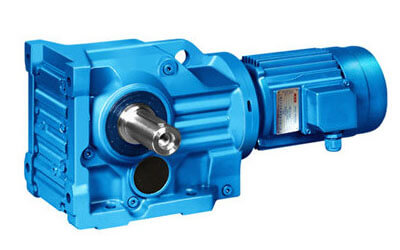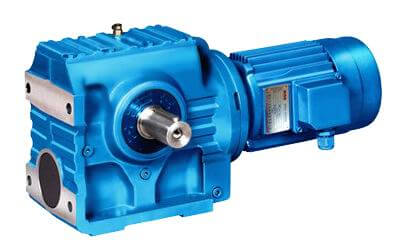K-series bevel helical gear reducers and S-series worm helical gear reducers exhibit significant differences in multiple dimensions such as transmission structure, performance parameters, and application scenarios. The specific comparisons are as follows:
1. Differences in Core Transmission Structure
K-Series: Combined Transmission of Helical Gears + Bevel Gears
It adopts a three-stage reduction structure:
- The motor output shaft first meshes with the primary pinion to complete the initial speed reduction.
- Then, spiral bevel gears (bevel gears) are used to achieve secondary speed reduction and change the transmission direction (the input shaft and output shaft are staggered at 90°).
- Finally, the tertiary helical gear meshing completes the final speed reduction, and power is transmitted through the hollow output shaft.
All gears adopt carburizing and quenching as well as gear grinding processes, featuring high tooth surface hardness (up to HRC60 or above) and high meshing accuracy, which makes them suitable for heavy-load transmission.
S-Series: Combined Transmission of Helical Gears + Worm Gears
It adopts a two-stage reduction structure:
- The first stage is helical gear meshing for speed reduction.
- The second stage uses worm and worm gear meshing for further speed reduction and changing the transmission direction.
The meshing between the worm and worm gear is sliding friction. Some models utilize this characteristic to achieve a self-locking function (preventing load reversal after power failure), but the friction loss is relatively large.
2. Comparison of Key Performance Parameters
| Parameter Category | K-SERIES BEVEL HELICAL GEAR REDUCER | S-SERIES WORM HELICAL GEAR REDUCER |
|---|---|---|
| Frame Size Range | 37-187 (wide specification range) | 37-97 (only 7 specifications) |
| Input Power | 0.12-200kW (supports high-power input) | 0.12-22kW (mainly for medium and low power) |
| Output Torque | 10-62800N.m (super large torque output) | 11-4530N.m (lower torque upper limit) |
| Transmission Efficiency | Up to 95% or above (low loss in pure gear transmission) | Lower than that of K-series (large friction loss in worm and worm gear sliding friction) |
| Transmission Ratio Range | 5.36-14526 (wide range coverage) | 7.5-14000 (limited single-stage ratio; large ratio achievable with two-stage) |
| Operating Noise | Low (precision gear meshing, low vibration) | Extremely low (stable meshing of worm and worm gear, sliding friction suppresses noise) |
3. Structural and Installation Characteristics
Output and Installation Forms
- K-Series: It features vertical output and adopts a rigid cast iron housing. It has high structural strength but a relatively large volume, and supports modular combination (can be flexibly matched with motors and brakes).
- S-Series: It adopts worm gear-type output. The concave-convex design on the reducer surface serves both heat dissipation and vibration absorption functions. It has a more compact and lightweight structure, supports multiple installation methods such as foot mounting, flange mounting, and shaft mounting, and is suitable for narrow spaces.
Differences in Core Functions
- K-Series: It has no self-locking function, and an additional braking device is required to meet positioning needs.
- S-Series: Some models are equipped with a built-in self-locking function, offering higher safety, which is especially suitable for scenarios such as lifting and conveying that require anti-reversal.
4. Application Scenarios and Costs
Application Fields
- K-Series: Suitable for high-torque and high-power working conditions, such as heavy industrial equipment including food processing production lines, chemical mixing equipment, and construction machinery (tower cranes, elevators).
- S-Series: Applicable to scenarios with medium and low loads that require high stability and safety, such as robot joints, automated assembly lines, theater driving devices, and turntables. It can also be used in harsh environments such as humidity and corrosion (due to good sealing performance).
Cost and Maintenance
- Procurement Cost: The S-series has a simpler structure, and its price is usually lower than that of the K-series of the same specification.
- Maintenance Cost: The K-series requires a higher initial investment, but its gears have strong wear resistance and a long service life, resulting in lower maintenance costs. The S-series requires regular replacement of high-quality lubricating oil (worm and worm gear have high requirements for lubrication), leading to slightly higher long-term maintenance costs.
5. Selection Recommendations
- If high power, large torque, and efficient transmission are required (e.g., heavy machinery), the K-series is preferred.
- If installation in narrow spaces, low noise, and self-locking function are required (e.g., precision automated equipment), the S-series is preferred.




